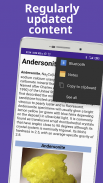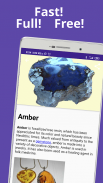










Minerals guide
Geology

Minerals guide: Geology介绍
一本大百科全书“矿物指南:地质学工具包”是一本完整的免费术语手册,涵盖了最重要的术语和概念。这让地质学家和爱好者可以检查和探索矿物、岩石、宝石和晶体特征。
矿物学是一门专门研究矿物和矿化人工制品的化学、晶体结构和物理特性的地质学学科。矿物学的具体研究包括矿物起源和形成的过程、矿物的分类、它们的地理分布以及它们的利用。
识别矿物的第一步是检查其物理特性,其中许多特性可以通过手样测量。这些可以分为密度(通常以比重表示);机械内聚力的测量(硬度、韧性、解理、断裂、分离);宏观视觉特性(光泽、颜色、条纹、发光、透明度);磁电性能;放射性和在氯化氢中的溶解度
晶体或结晶固体是一种固体材料,其成分(如原子、分子或离子)以高度有序的微观结构排列,形成向各个方向延伸的晶格。此外,宏观单晶通常可以通过其几何形状来识别,由具有特定特征取向的平面组成。对晶体和晶体形成的科学研究被称为晶体学。通过晶体生长机制形成晶体的过程称为结晶或凝固。
晶体学是确定晶体中原子排列的实验科学。晶体学是材料科学和固态物理学(凝聚态物理学)领域的一门基础学科。在晶体学中,晶体结构是对晶体材料中原子、离子或分子有序排列的描述。有序结构从组成粒子的固有性质中产生,形成沿物质三维空间的主要方向重复的对称模式。
一些矿物是化学元素,包括硫、铜、银和金,但绝大多数是化合物。识别成分的经典方法是湿化学分析,它涉及将矿物溶解在酸中。
类矿物是一种天然存在的类矿物物质,不具有结晶性。类矿物的化学成分变化超出了特定矿物普遍接受的范围。
宝石(也称为宝石、珠宝、宝石或半宝石)是一块经过切割和抛光后用于制作珠宝或其他装饰品的水晶。大多数宝石是坚硬的,但一些软矿物因其光泽或其他具有审美价值的物理特性而被用于珠宝中。稀有性是赋予宝石价值的另一个特征。
金是一种化学元素,符号为 Au(来自拉丁语 aurum“金”),原子序数为 79。这使其成为自然界中原子序数较高的元素之一。它是一种明亮、略带橙黄色、致密、柔软、有延展性和延展性的纯净金属。
大约有 4000 种不同的宝石,每一种都具有独特的物理特性。这些包括:颜色、条纹、硬度、光泽、透明度、比重、解理、断裂、磁性、溶解度等等。
这本词典免费离线:
• 具有自动完成功能的高级搜索功能;
• 声音搜索;
• 离线工作——应用程序自带的数据库,搜索时不产生数据费用;
• 包括数百个示例来说明定义;
“矿物指南”是使您所需信息触手可及的最佳方式。


























